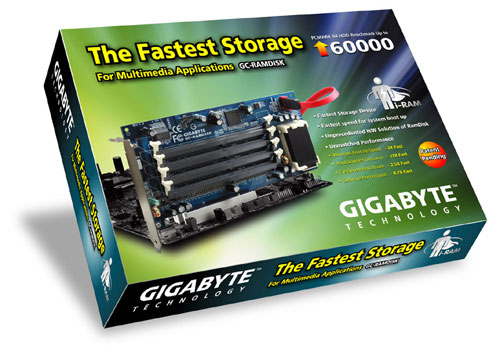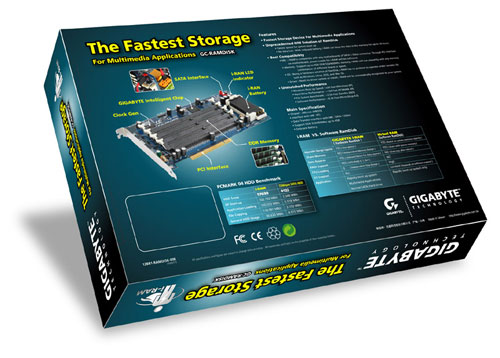Gigabyte's i-RAM: Affordable Solid State Storage
by Anand Lal Shimpi on July 25, 2005 3:50 PM EST- Posted in
- Storage
For years now, motherboard manufacturers have been struggling to find other markets to branch out to, in an attempt to diversify themselves, preparing for inevitable consolidation in the market. Every year at Computex, we'd hear more and more about how the motherboard business was getting tougher and we'd see more and more non-motherboard products from these manufacturers. For the most part, the non-motherboard products weren't anything special. Everyone went into making servers, then multimedia products, then cases, networking, security, water cooling; the list goes on and on.
This year's Computex wasn't very different, except for one thing. When Gigabyte showed us their collection of goodies for the new year, we were actually quite interested in one of them. And after we posted an article about it, we found that quite a few of you were very interested in it too. Gigabyte's i-RAM was an immediate success and it wasn't so much that the product was a success, but it was the idea that piqued everyone's interests.
Pretty much every time a faster CPU is released, we always hear from a group of users who are marveled by the rate at which CPUs get faster, but loathe the sluggish rate that storage evolves. We've been stuck with hard disks for decades now, and although the thought of eventually migrating to solid state storage has always been there, it's always been so very distant. These days, you can easily get a multi-gigabyte solid state drive if you're willing to spend the tens of thousands of dollars it costs to get one; prices actually vary from the low $1000s to the $100K range for solid state devices, obviously making them impractical for desktop users.
The performance benefits of solid state storage have always been tempting. With no moving parts, reliability is improved tremendously, and at the same time, random accesses are no longer limited by slow and difficult to position read/write heads. While sequential transfer rates have improved tremendously over the past 5 years, thanks to ever increasing platter densities among other improvements, it is the incredibly high latency that makes random accesses very expensive from a performance standpoint for conventional hard disks. A huge reduction in random access latency and increase in peak bandwidth are clear performance advantages to solid state storage, but until now, they both came at a very high price.
The other issue with solid state storage is that DRAM is volatile, meaning that as soon as power is removed from the drive, all of your data would be lost. More expensive solutions get around this by using a combination of a battery backup as well as a hard disk that keeps a backup of all data written to the solid state drive, just in case the battery or main power should fail.
Recognizing the allure of solid state storage, especially to performance-conscious enthusiast users, Gigabyte went about creating the first affordable solid state storage device, and they called it i-RAM.
Through some custom logic, the i-RAM works and acts just like a regular SATA hard drive. But how much of a performance increase is there for desktop users? And is the i-RAM worth its still fairly high cost of entry? We've spent the past week trying to find out...
This year's Computex wasn't very different, except for one thing. When Gigabyte showed us their collection of goodies for the new year, we were actually quite interested in one of them. And after we posted an article about it, we found that quite a few of you were very interested in it too. Gigabyte's i-RAM was an immediate success and it wasn't so much that the product was a success, but it was the idea that piqued everyone's interests.
Pretty much every time a faster CPU is released, we always hear from a group of users who are marveled by the rate at which CPUs get faster, but loathe the sluggish rate that storage evolves. We've been stuck with hard disks for decades now, and although the thought of eventually migrating to solid state storage has always been there, it's always been so very distant. These days, you can easily get a multi-gigabyte solid state drive if you're willing to spend the tens of thousands of dollars it costs to get one; prices actually vary from the low $1000s to the $100K range for solid state devices, obviously making them impractical for desktop users.
The performance benefits of solid state storage have always been tempting. With no moving parts, reliability is improved tremendously, and at the same time, random accesses are no longer limited by slow and difficult to position read/write heads. While sequential transfer rates have improved tremendously over the past 5 years, thanks to ever increasing platter densities among other improvements, it is the incredibly high latency that makes random accesses very expensive from a performance standpoint for conventional hard disks. A huge reduction in random access latency and increase in peak bandwidth are clear performance advantages to solid state storage, but until now, they both came at a very high price.
The other issue with solid state storage is that DRAM is volatile, meaning that as soon as power is removed from the drive, all of your data would be lost. More expensive solutions get around this by using a combination of a battery backup as well as a hard disk that keeps a backup of all data written to the solid state drive, just in case the battery or main power should fail.
Recognizing the allure of solid state storage, especially to performance-conscious enthusiast users, Gigabyte went about creating the first affordable solid state storage device, and they called it i-RAM.



Through some custom logic, the i-RAM works and acts just like a regular SATA hard drive. But how much of a performance increase is there for desktop users? And is the i-RAM worth its still fairly high cost of entry? We've spent the past week trying to find out...










133 Comments
View All Comments
Aganack1 - Monday, July 25, 2005 - link
i thought they said that they were only going to make 1000. enought for the crazies who have money to burn...P.S. if any of you crazies are reading this i could burn some of that money for you... just let me know.
Houdani - Monday, July 25, 2005 - link
Thanks for running through the multiple roles for which the iRam might be useful. I'm rather surprised it wasn't MORE useful in the benches. I'd be interested in learning (i.e. slacking back and reading the results of someone else's research) why the i-Ram is still as large a bottleneck as it is. Yes it's faster than the HD, but why isn't it much, much faster? Are we seeing OS inefficiency or something else altogether?In the end, though, it doesn't fit my needs particularly well, so I'll pass this round. Maybe a future version will be more appealing in terms of cost, speed, size.
Sunbird - Monday, July 25, 2005 - link
maybe the SATA interface isn't fast enough?pio!pio! - Monday, July 25, 2005 - link
I'm constantly shuffling 1--3 gb mpeg2 files around...this would be greatGed - Monday, July 25, 2005 - link
Would it be possible for an NVIDIA or ATI graphics card that used TurboCache or HyperMemory to make use of the i-RAM?That might be interesting.
Anton74 - Monday, July 25, 2005 - link
No, absolutely not. Even if it were, the SATA interface is *way* too slow to be of use for something like that.And even if that were not a factor, why spend that kind of money on the i-RAM where the same amount would buy a *much* superior video card with its own dedicated memory?
Anton
kleinwl - Monday, July 25, 2005 - link
I think that this would be very helpful as a page file for workstations. Older workstations may be maxed out with 4GB and windows 2000 (which the company does not want to move over to xp-64) and still need additional ram for CAD/CFD/etc. This would be an easy upgrade with a reasonable amount of performance increase.sandorski - Monday, July 25, 2005 - link
Was hoping it would offer more, especially as a Pagefile. Any plans to make a PCI-e version(IIRC PCI-e has a ton more bandwidth than SATA), that would likely make this a Must-have. As it stands now I'd only use it for the silence in a HT Setup.Gatak - Monday, July 25, 2005 - link
Using PCI/PCI-e for transfers would require OS drivers which wouldn't be available for all OSes.sprockkets - Tuesday, July 26, 2005 - link
Keep in mind that for many years the ide/sata controllers are NOT on the PCI bus of the southbridge, so PCI is not a limitation.